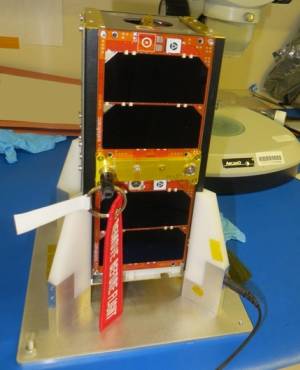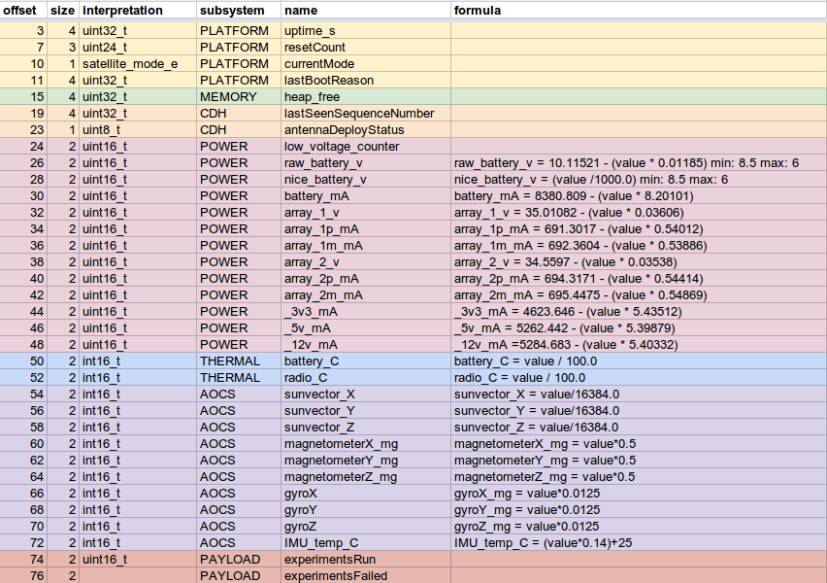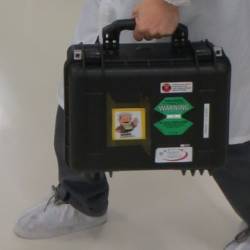CubeBUG-2 (AKA Manolito) Lusat Oscar 74
 Mission
Mission
It will carry an amateur radio AX.25 packet radio digipeater CubeBug-2 is the second technology demonstration mission for a new 2U CubeSat platform design (mechanics, hardware and software) intended to be released as Open Source and Open Hardware for its use in Amateur projects, University projects and Research labs. This project is sponsored by the Argentinian Ministry of Science, Technology and Productive Innovation.
As payload on this second mission, some custom designed components will be tested: an antenna, solar panels, and an on-board computer, a camera, a GPS transceiver and a software defined radio based on COTS components.
The satellite will be periodically transmitting AX.25 packets for the Amateur radio community to receive, and after the technology demonstration part of the mission is over, the satellite will enter a mode that will include a Digipeater, science data downloads from the payload (including images and recordings from the SDR, if possible). Proposing to use 1k2/9k6 FSK/GMSK AX25 on UHF with an AstroDev L1 transceiver.
Orbital parameters
Name CubeBUG-2 NORAD 39440 COSPAR designation 2013-066-AA Inclination 97.793 RA of A. Node 65.893 Eccentricity 0.0087167 Argument of Perigee 100.270 Revs per day 14.72248947 Period 1h 38m 48s (97.80 min) Semi-major axis 7 032 km Perigee x Apogee 593 x 715 km BStar (drag term) 0.000428660 1/ER Mean anomaly 260.834
Downlink
Beacon
437.445 MHz. FM 1k2 AFSK / 9k6 GFSK
Call
CUBEB2-6
Preliminarily TLE
CUBEBUG 2 1 00332U 00000 13325.30959780 .00000000 00000-0 10000-3 0 00000 2 00332 097.7920 038.2573 0082588 195.0614 340.2312 14.72794130000002
This TLE is good for planning passes and it’ll be also good for the initial tracking.
Telemetry
Manolito (CubeBug-2) will broadcast messages periodically, similar to what El Capitan Beto did (CubeBug-1), but with a different format, periodicity and content.
Signal modulation and encoding: Manolito will be using the same radio we used in El Capitán Beto, an AstroDev Li-1. Signals will be transmitted in UHF at 437.445 MHz, either AX.25 over 1200 bps AFSK or 9600 bps GFSK modulated on FM. For Manolito we decided to launch in a safer configuration then CubeBUG-1: The satellite will periodically (every 12 hours) switch from 1200 bps to 9600 bps and back, until we decide to fix a baud rate. The AX.25 packets will have CUBEB2-6 as source address and CQ as destination.
Periodicity: In the early days of CubeBug-1 we learned that it was very important to be know some of the state of the satellite even if it’s not possible to decode the telemetry packets. For Manolito we took it a bit further, and encoded some more information in the interval between each beacon. The interval time varies from 13 seconds to 36 seconds. 36, 35 and 34 seconds reflect three different internal errors related to obtaining the current battery voltage. Any other value is inversely proportional to the battery voltage. The main idea is twofold, to have a reading of the voltage and two make the radio consume less power when the battery is emptier. The formula to go back from seconds to voltage is: battery_v = 8.4v – (interval_s – 13s)/10
With this we’ll be able to tell the state of the batteries, whether the solar panels and power subsystem are working properly, if the CPU is working, etc.
Data format: The data in every packet Manolito sends starts with three bytes identifying the type of package, the most common anybody will receive are:
- FF FF F0: Binary telemetry beacon
- 3A 45 4D: ASCII telemetry beacon (APRS format)
- FF FF F4: Experiments results
- FF FF F5: Image fragment
Manolito will only start to broadcast the last two if everything goes well, there is good battery level, it has moved to MISSION mode and it started to automatically run some experiments. We’ll talk about this packets in a future post, as soon as we start seeing them.
The ASCII telemetry beacon is just a text stating some basic telemetry, including battery voltage, gyroscopes measurement, uptime and temperature. It looks like: Upt: 03:24:06 Bat:7.98v Temp:27.6C Gyr:0.45d/s. The binary telemetry beacon is bit more complex, and contains lots of interesting information about the Manolito’s health condensed in 78 bytes:

CubeBUG-2 9k6 decode 21-11-2013:
2013-11-21 14:59:10.800 UTC: [98 Bytes KISS Frame (without CRC)]
ctrl: 3 PID: F0 {UI} 78 Payload Bytes
from CUBEB2-6 to CQ:
1 > FF FF F0 00 00 14 CA 00 00 01 03 00 00 00 00 00 00 3D E0 00
21 > 00 00 00 AF 00 01 00 CA 1E 77 03 F7 02 C9 03 FF 03 FF 02 D9
41 > 02 B6 03 FF 03 3F 03 B6 03 C4 0A C7 05 01 C5 AA 19 F8 FB B8
61 > 03 DB FD DD FF 65 09 47 02 51 E3 8A FF 6C 00 00 00 00
ÿÿð...Ê..........=à....¯...Ê.w.÷.É.ÿ.ÿ.Ù.¶.ÿ.?.¶.Ä.Ç..Ū.øû¸.ÛýÝÿe.G.QãŠÿl....
In a later pass also an APRS message from CubeBUG-2:
1:Fm CUBEB2-6 To CQ [13:34:56R] :EMAIL :manolito@satellogic.com Upt: 04:41:43 Bat:7.90v Temp:27.6C Gyr:87.77d/s
Status
CubeBug-2 is expected to be launched as part of a group of CubeSats in a Dnepr rocket launch planned for November 2013 from Yasny launch site. Active, received and decoded.
Latest news
03-December-2013: Mr Manolito/Cubebug-2 has been designated by Bill Tynan, W3XO OSCAR Number Administrator AMSAT-NA as Oscar number LO-74 as Lusat Oscar 74.
 02-September-2013: CubeGug-2 is on its way to ISIS in The Netherlands for final assembly and flight preparations.
02-September-2013: CubeGug-2 is on its way to ISIS in The Netherlands for final assembly and flight preparations.
17-August-2013: CubeBug-2 (Manolito), is almost ready for shipping now, it was a hell of a trimester, and still a bit less than a month to go.
In terms of radio, saddly, we did not change the radio device, however:
- The hardware problem that injected a DC in the modulation chain is
fixed, and the signal now looks a lot better. We got help from Adrian
there too to assess how much better it was. It is. - We are changing a bit our comms strategy. All in all very similar, but
all packets will go out both in 9600 and 1200, until we decide which one
to keep. - Experiment results will be periodically broadcasted, even if no cmd
can reach the satellite. - It will, hopefully include some small HAM/APRS features for all to
try. Don’t expect much there, maybe a PING a DX and some other features. - Callsign will likely be CUBEB2-6 so it shows a satellite icon
Homepage and other references:
